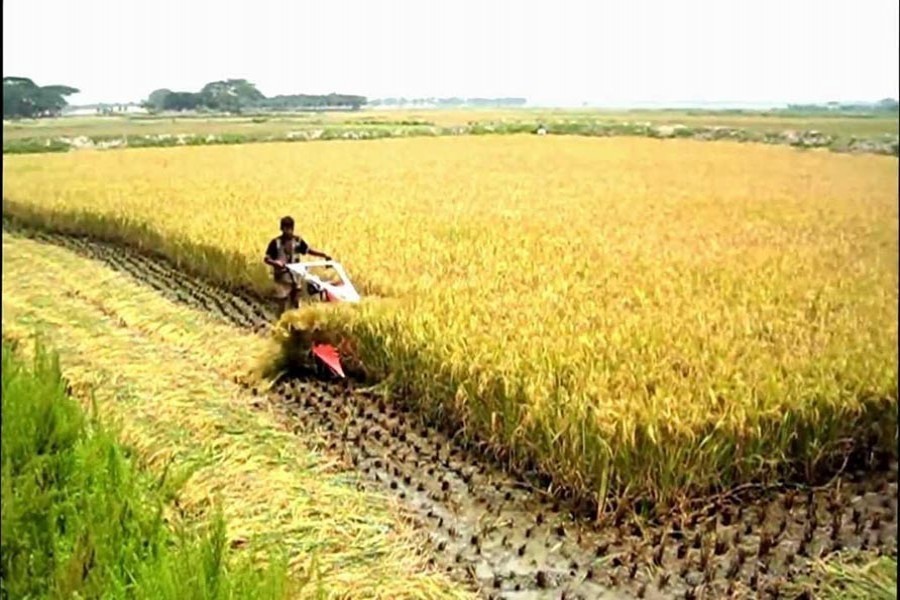During a recent trip to a rural area famous for its abundance of crop productions, vast tracts of its paddy fields, it was found shorn of its earlier natural look. The area was well known for its production of various kinds of paddy. Once it was also considered one of the country's jute cultivation hubs.
During the leisurely trip, visitors couldn't help being shocked at the strange look the fields' views offered. Miles after miles the vast riverside land wore a bare and barren look, with only patches of shrubs and wild grass grown here and there. It was the pre-harvest season of a high-yielding variety of paddy. The normal view should have been one of unalloyed green. The vastness of the paddy fields has been a common sight to the villagers for ages. The captivating rural spectacle is gone.
Over the last 15/20 years, these green fields have become illusory. No longer covered by the topsoil vital to crop yields, the fields have continued losing their productivity. Few agronomists could think that the deterioration in the country's crop fields might reach such an extent that it would lead to their virtual death. After showing the initial signs of barrenness, at one point of time the agricultural plots became appallingly deficient in their topsoil. Finally the process became complete. Massive tracts of once-fertile agricultural lands in different parts of the country were deserted by farmers. Many left their ancestral profession. All these developments appeared as portents of the loss of the country's self-reliance in food production in the long run.
In the past two decades, the country's vast expanses of agro-lands have lost their topsoil. It hasn't vanished in any natural process. The all-important soil invariably ended up being the chief raw-material for bricks built at the recklessly sprouting brick kilns. These factories operating close to the crop fields are now a common view in rural Bangladesh. The brick kiln owners do not care a fig about the apparently existing laws prohibiting the operation of brick kilns near agricultural plots. With a thickness of 5-10 inches, the upper layer of an agro-plot is called topsoil. It is considered the highest concentration of organic matter and microorganisms. It is in this section where the planet earth's biological soil activity occurs.
The brick fields have identified the topsoil as the chief component of the products manufactured in their furnace-based factories. As almost eighty per cent of the country's brickfields use topsoil from the farmlands nearby, these factories exact a heavy toll on agro-plots. The brick kiln owners employ numerous types of techniques to collect the soil from farmers. Once they target a plot rich in topsoil, farmers are compelled to part with that valuable segment of their land. Eventually, the process becomes an act of plundering. To grab the soil from farmers, the factory owners employ their agents to conduct negotiations with a plot owner. If a farmer refuses to sell his land's topsoil, he is threatened with 'dire consequences'. The advantage most of the brick kiln owners enjoy is their ability to wield power due to their being influential locally. To speak pithily, poor farmers are coerced into selling their topsoil to the brickfield owners at a price fixed arbitrarily by brokers.
The normal spectacle nowadays in many villages comprises hundreds of tractors and trucks collecting and carrying topsoil to the factory sites. According to soil scientists, following the extraction of topsoil from agro-plots 5.0 per cent of organic matter in the soil gets lost. It takes several decades for a layer of topsoil to form with a depth of 6.0 to 8.0 inches. It has long been proved that topsoil comprises the most vital upper layer of agricultural lands. Their wholesale depletion contributes to a fast creeping of the process of agricultural land's infertility. Barrenness of the once-fertile soil of this deltaic land is fast emerging as a distressing reality. The archaic, as well as unscientific, cropping pattern, i.e. farming on the same land without break, had been contributing to fast loss of the soil's natural nutrients. Given this fact, the process of barrenness of Bangladesh agricultural soil has set for long. The brick kilns' plunder of topsoil only aggravated the situation. A most troubling aspect of topsoil excavation is its destruction of the soil's organic matter and humus. Numerous species of parasites live at the upper topsoil level. These agents of plant nutrition, which help plants process food, get spoiled with the topsoil removal. In the long run, the soil becomes a mass of mere dust devoid of normal fertility. Another negative aspect the agronomists have long been singling out is worth noting. With the upper layer of the farmland soil gone, pro-production organisms such as earthworms enter a seemingly irreversible cycle of extinction. This expedites the fast change in a land's soil nature and features.
The thought of green bricks produced without traditional furnace at facilities fitted with tunnel kilns not spewing toxic smoke has long been mulled. Successive governments have backed the idea. Demonstrative researches have shown positive results. These new-age bricks have received wholehearted support from all quarters, ranging from agronomists, the construction sector and the environmental activists. According to different quarters, only widespread use of the alternative bricks can effectively stop the topsoil loss, and the fast advancing barrenness of farmlands.


